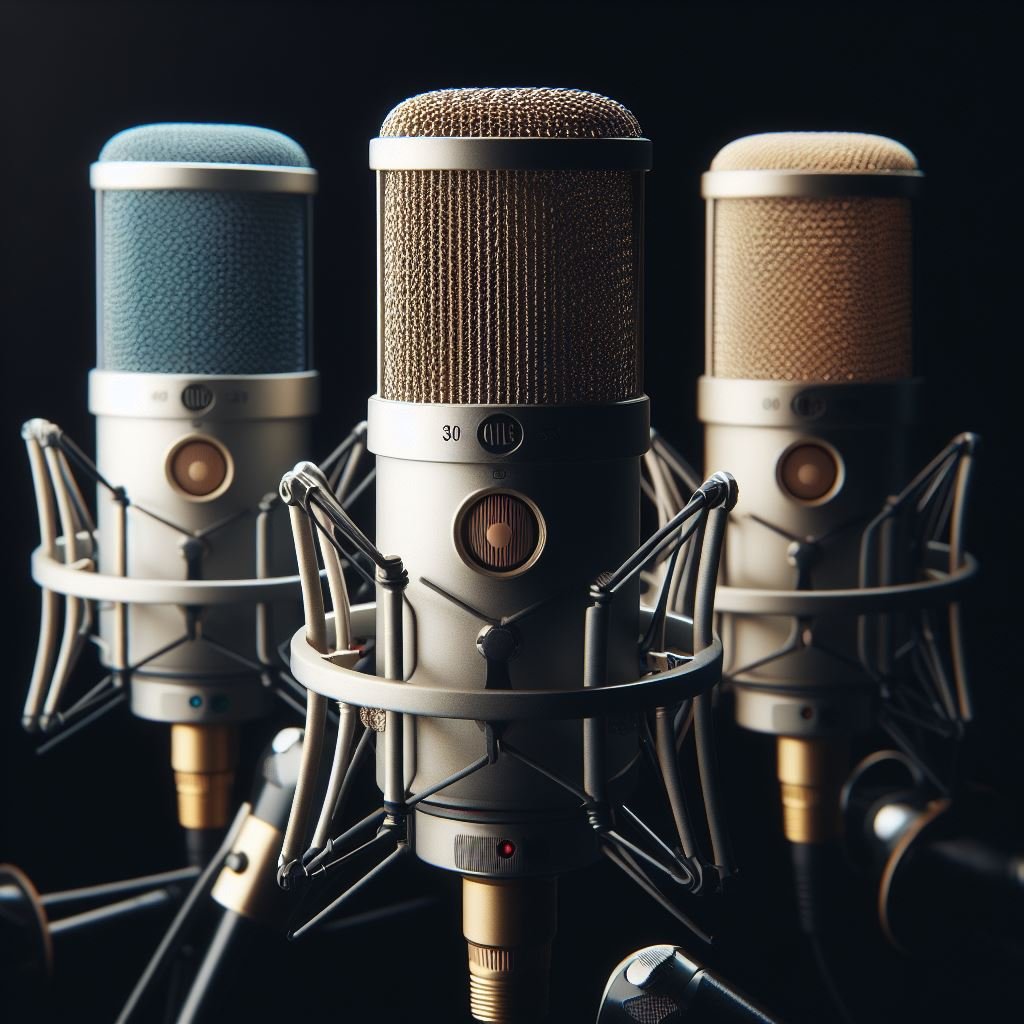1.Introduction
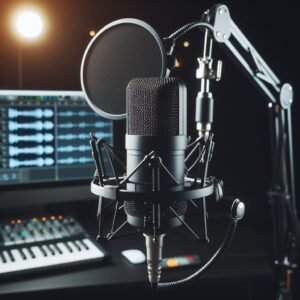
.Condenser microphones are a type of microphone that are known for their ability to capture sound with exceptional clarity and sensitivity. They work by using an electrostatic principle, which involves a diaphragm and backplate to create a capacitor. This allows them to pick up even the slightest sounds with great detail
Compared to other types of microphones, condenser microphones are more sensitive and can capture a wider range of frequencies. However, they are also more prone to picking up unwanted background noise. They are commonly used in recording studios and for live performances, where high-quality sound is essential
In other words……….
A condenser microphone is a specialized audio device known for its exceptional sensitivity and clarity in capturing sounds.
Unlike regular mics, it works on an electrostatic trick. Picture it having a special duo – a diaphragm and backplate – creating magic like a capacitor.
When you make a sound, this dynamic duo reacts, turning it into an electric signal. These mics, like any good wizard, need a bit of power, usually from batteries or a phantom power source. Perfect for studios, podcasts, and live gigs, condenser mics grab every little sound detail, giving your recordings that pro-level crispness.
Importance of Condenser Microphones in audio recording and broadcasting
1. Precision Recording: Condenser microphones are known for their ability to capture sound with exceptional detail and accuracy. They are able to pick up subtle nuances and variations in the sound, making them ideal for precision recording of vocals, acoustic instruments, and other delicate sound sources.
2. Versatility: Condenser microphones are versatile and can be used in a wide range of recording applications. They are suitable for capturing a variety of sound sources, from vocals to orchestral instruments, making them a valuable tool in the audio recording process. Their versatility makes them a popular choice for professional studios and home recording setups alike.
Importance in Broadcasting:
Broadcast-Quality Sound: Condenser microphones elevate the audio quality in broadcasting, ensuring clear and professional-sounding content.
Podcasting Brilliance: Ideal for podcasting, condenser mics enhance the host’s voice and capture guest discussions with unmatched clarity.
In essence, condenser microphones play a vital role in delivering superior audio quality, making them a preferred choice for professionals in both recording studios and broadcasting settings.
History of Condenser Microphones
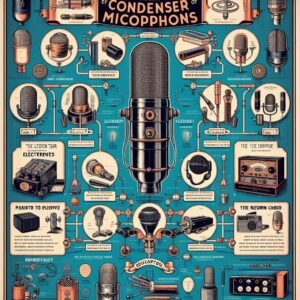
The history of condenser microphones began in the early 20th century with the development of the first practical condenser microphone by E.C. Wente and A.L. Thuras at Bell Laboratories in the 1910s. This invention revolutionized audio recording and transmission by providing a more sensitive and accurate method of capturing sound.
Condenser microphones work by using a diaphragm placed near a charged backplate. As sound waves cause the diaphragm to vibrate, the distance between the diaphragm and backplate changes, resulting in variations in capacitance that are converted into an electrical signal representing the original sound wave.
Initially used in telecommunications and broadcasting due to their high sensitivity, early condenser microphones were large and required high-voltage power supplies, limiting their portability. However, advancements in technology in the 1950s and 1960s led to smaller, more efficient designs suitable for studio recording. Solid-state electronics and phantom power further contributed to their widespread adoption in professional audio applications.
Today, condenser microphone technology continues to evolve, leading to high-quality yet affordable models widely used in home recording studios and podcasting setups. Their versatility and precision have solidified their place as essential tools for capturing vocals, acoustic instruments, and various sound sources with exceptional detail and accuracy.
Types of Condenser Microphones
Condenser microphones come in various shapes and sizes, each designed to cater to specific recording needs. Understanding the distinctions between large-diaphragm, small-diaphragm, and electret condenser microphones is crucial for selecting the right tool for the job.
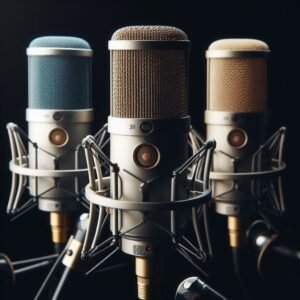 Large-Diaphragm Condenser Microphones:
Large-Diaphragm Condenser Microphones:
Large-diaphragm condenser microphones are the workhorses of the recording world, known for their ability to capture a wide range of frequencies with exceptional detail. The defining feature of these mics is their diaphragm size, typically exceeding one inch in diameter. This larger diaphragm contributes to their sensitivity, making them ideal for recording vocals and low-frequency instruments like guitars and drums. Their ability to capture nuanced performances with warmth and depth has made them a staple in studio environments, especially for genres like jazz, blues, and rock.
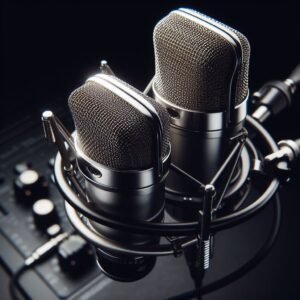 Small-Diaphragm Condenser Microphones:
Small-Diaphragm Condenser Microphones:
In contrast, small-diaphragm condenser microphones are characterized by a diaphragm typically less than one inch in diameter. These mics excel in capturing high-frequency sounds with precision and detail. They are well-suited for recording acoustic instruments such as violins, acoustic guitars, and cymbals due to their faster transient response. Small-diaphragm condensers are also preferred for stereo recording techniques like XY and ORTF configurations, making them versatile tools for capturing the spatial aspects of a performance. Their compact size and accurate reproduction make them valuable in live recording scenarios and classical music settings.
Electret Condenser Microphones: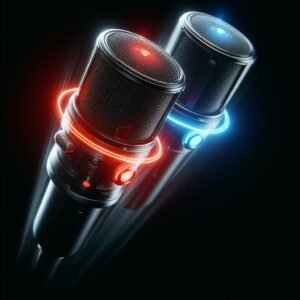
Electret condenser microphones represent a technological advancement in condenser microphone design. Unlike traditional condenser mics that require an external power source, electret condenser microphones have a permanently charged diaphragm. This design simplifies power requirements, making them more portable and user-friendly. Electret condenser microphones find applications in diverse settings, from consumer-grade recording devices to professional environments. They are commonly used in video cameras, smartphones, and lavalier microphones due to their compact size and power efficiency.
Understanding the nuances of these condenser microphone types empowers recording engineers, musicians, and content creators to make informed choices based on the specific demands of their projects. Whether aiming for the warmth of a large-diaphragm condenser, the precision of a small-diaphragm condenser, or the convenience of an electret condenser, each type plays a unique role in shaping the sonic landscape of the audio being captured
Advantages and Limitations of Condenser Microphones
Condenser microphones offer several advantages that make them popular in professional audio recording and broadcasting. One key advantage is their high sensitivity, which allows them to capture subtle nuances and details in sound, making them ideal for recording vocals, acoustic instruments, and ambient sounds. They also have a wide frequency response, enabling them to accurately reproduce a broad range of audio frequencies. Additionally, condenser microphones typically have low self-noise, resulting in clean and clear recordings.
Another advantage of condenser microphones is their transient response, meaning they can accurately capture the fast and dynamic changes in sound, making them suitable for capturing the full range of musical performances. Furthermore, their ability to handle high sound pressure levels makes them versatile for recording loud sources without distortion.
However, condenser microphones also have limitations. They are generally more sensitive to environmental conditions such as humidity and temperature variations compared to dynamic microphones. Additionally, they require a power source, either in the form of batteries or phantom power from a mixer or audio interface. This power requirement can limit their portability and use in certain live sound applications.
Condenser microphones are also more fragile than dynamic microphones due to their diaphragm design, making them more susceptible to damage from rough handling or high-pressure sound sources. Additionally, they can be more expensive than dynamic microphones, particularly high-end studio models. Despite these limitations, the exceptional sound quality and versatility of condenser microphones make them indispensable tools for professional audio recording and critical listening applications.
